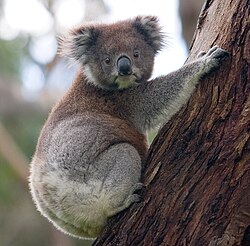Vombatiformes
| Vombatiformes Temporal range: Late Oligocene - Recent |
|
|---|---|
 |
|
| Phascolarctos cinereus | |
| Scientific classification | |
| Kingdom: | Animalia |
| Phylum: | Chordata |
| Class: | Mammalia |
| Subclass: | Theria |
| Infraclass: | Marsupialia |
| Order: | Diprotodontia |
| Suborder: |
Vombatiformes Burnett, 1830 |
| Families | |
The Vombatiformes are one of the three suborders of the large marsupial order Diprotodontia. Five of the seven known families within this suborder are extinct; only the families Phascolarctidae, with the koala, and Vombatidae, with three extant species of wombat, survive.
Among the extinct families are the Diprotodontidae, which includes Diprotodon, believed by many to be the inspiration for the bunyip. "Vombatiformes" is neo-Latin for "wombat-shaped things", and took its name from its type family.
The suborder Vombatiformes, with its closely related members and their compact body form, contrasts with the other two diprotodont suborders, the Macropodiformes: kangaroos, wallabies, and quokkas; and the Phalangeriformes: possums, including the gliders such as the wrist-winged gliders. The koala and wombats are believed by many biologists to share a common ancestor and to have diverged only recently in the Cenozoic.
Suborder Vombatiformes
...
Wikipedia
